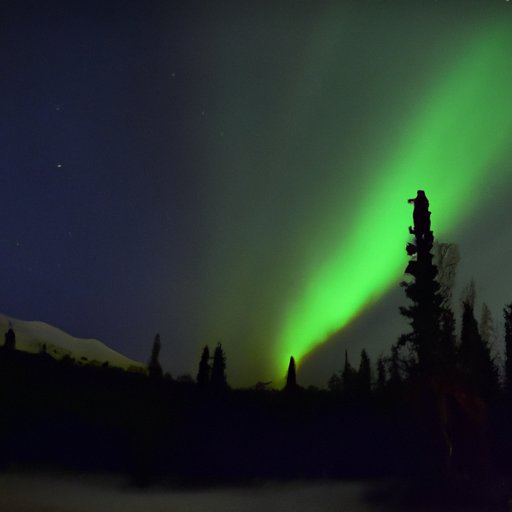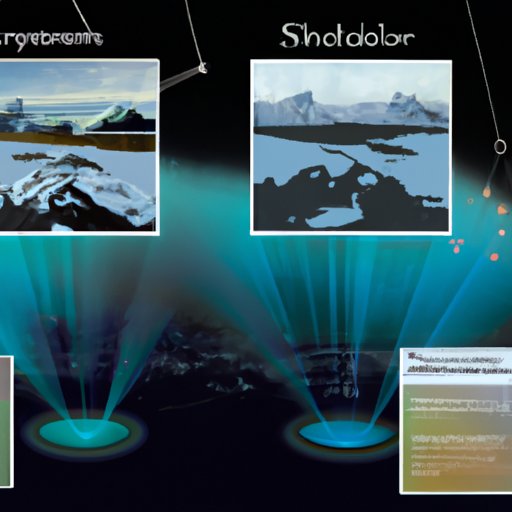
I. Introduction
One of nature’s most spectacular light shows, the Northern Lights, also known as Aurora, is a magnificent display of electrified particles from the sun colliding with Earth’s magnetic field. This beautiful phenomenon can be seen in several locations in the world, but Alaska is often considered the best place to experience it. In this article, we’ll explore when and where the Northern Lights are visible in Alaska and offer tips on how to plan an Aurora-focused trip.
II. Magnificent Light Show: A Guide to Catching the Northern Lights in Alaska
The Northern Lights appear in the sky as a dynamic dance of colors, usually green, sometimes purple, pink and even red. This breathtaking display is the result of charged particles from the sun colliding with gas molecules in Earth’s atmosphere. To have a successful viewing experience, it’s essential to prepare and plan carefully. Having the right equipment, the proper clothing, and knowing the ideal time and place to see the Aurora is critical.
When preparing for an Aurora trip, it’s important to bring along warm clothing, preferably layers, and waterproof gear. It’s also recommended to bring a good camera or smartphone as capturing the beauty of the Aurora can create unforgettable memories.
III. Chasing Aurora: Exploring the Best Times and Places to Witness the Northern Lights in Alaska
The Northern Lights can be visible in Alaska from mid-September to late April, but the best months are October, February, and March. During this period, the nights are longer, and the weather conditions are more favorable. The Northern Lights can be seen anywhere in Alaska, but some locations offer a better view than others. Such locations include Fairbanks, Anchorage, and Denali National Park.
Weather conditions play a crucial role in determining the visibility of the Aurora. It’s important to choose a viewing spot with clear skies and minimal light pollution. One resource to use when choosing a viewing spot is the University of Alaska’s “Aurora Forecast,” which provides real-time forecasts for Aurora sightings.
IV. Glimpsing the Galaxy: Understanding When You Can Spot the Northern Lights in Alaska
The Aurora is a natural phenomenon based on solar activity that is difficult to predict accurately. However, with the right resources, predicting a potential Northern Lights sighting becomes possible. The University of Alaska’s “Aurora Forecast” and the Geophysical Institute’s “Aurora Tracker” are two resources that provide real-time updates as well as the probability of Aurora sightings for that day.
The intensity and visibility of the Aurora are also influenced by other environmental factors such as moon phases, solar flares, and geomagnetic storms. To increase the chances of seeing the Aurora, it’s best to keep abreast of these environmental factors and plan carefully accordingly.
V. Aurora Adventures: Planning Your Northern Lights Excursion in Alaska
When planning a trip to Alaska to witness the Aurora, there are several travel and accommodation options available. Consider traveling to Fairbanks, Anchorage, or other cities with easy access to Aurora viewing spots. Many tour companies offer Aurora-focused trips, which can include activities such as dog sledding, ice fishing, and snowshoeing.
It’s a good idea to combine Aurora viewing with other winter activities since the Northern Lights are an unpredictable phenomenon. Other winter activities would include visiting a natural hot spring, taking in a sled dog race, skiing, or indulging in a hot chocolate by the fire.
Ensure that you have appropriate travel insurance, in case of any unforeseen circumstances, such as a flight cancellation due to weather conditions or a medical emergency. Also, it’s essential to make reservations for accommodation and activities in advance to avoid last-minute cancellations.
VI. The Magic of Alaska’s Northern Lights: A Comprehensive Guide to Seeing the Aurora Borealis
To sum up, the Northern Lights, the Aurora Borealis, is an incredible natural phenomenon that everyone should experience at least once in their lifetime, and Alaska is undoubtedly one of the best places in the world to witness it. When planning a trip to Alaska, it’s essential to prepare, plan and have the right resources for a successful viewing experience. Alaska’s natural beauty and the dancing sky will make the trip unforgettable.
VII. Capturing the Dancing Sky: Tips for Viewing the Northern Lights in Alaska
To enhance the Aurora viewing experience, it’s recommended to find a spot with a clear view of the sky, away from light pollution. Also, the ideal time to view the Aurora is between 10 pm and 2 am. It’s also important to know how to frame and time the shots when photographing the Aurora. Try using a tripod to keep your camera stable while setting a shutter speed of 10 seconds or more.
It’s also essential to stay safe during outdoor viewing. Dress warmly, and, when using a campfire to keep warm, ensure that it’s extinguished before leaving the site. It’s also recommended to avoid alcohol when viewing the Northern Lights.

VIII. Unlocking the Secrets of the Northern Lights in Alaska: When and Where to See the Spectacular Aurora
If you’re short on time and unable to read this entire guide, here are the most important points to remember. The best time to see the Aurora in Alaska is between October and March. It’s important to choose a location with clear skies and minimal light pollution. Use the “Aurora Forecast” and the “Aurora Tracker” as resources to predict potential sightings. Prepare adequately by bringing along warm clothing, a good camera, and other necessary equipment.
IX. Conclusion
The Northern Lights, the Aurora Borealis, is a natural wonder that has inspired and captivated people for centuries. Alaska, with its pristine wilderness and clear skies, is undoubtedly one of the best places in the world to witness this breathtaking spectacle. With careful planning and preparation, anyone can experience the majesty of the Aurora in Alaska and create unforgettable memories for a lifetime.
Don’t waste another minute, book your trip today and come and witness the dancing sky in all its glory.




